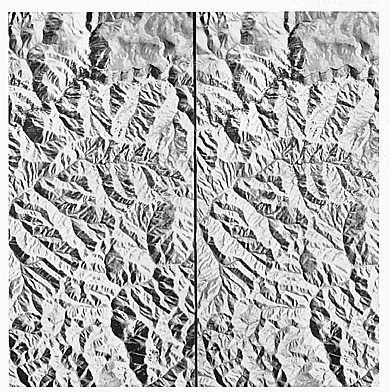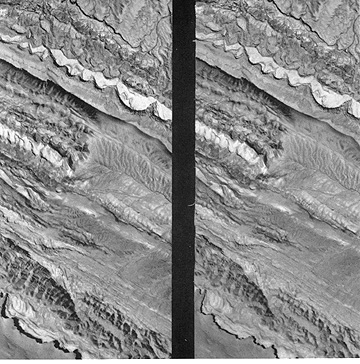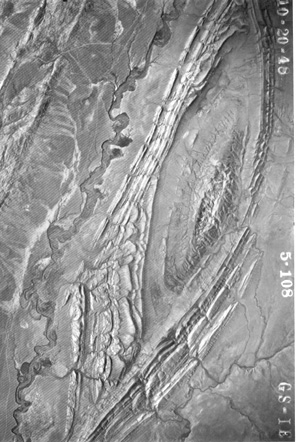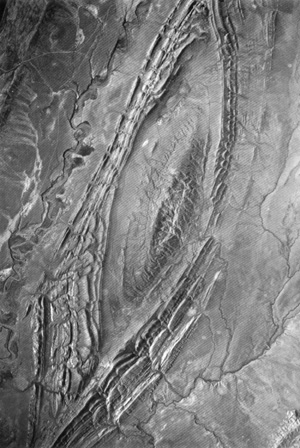
This style of viewing is as familiar as seeing. When you close one eye, look at some object in the room, then blink open that eye while simultaneously closing the other, and repeat this rapidly, the end effect is that the object appears to slightly move laterally. This shift is even more dramatic when you hold an index finger about 30 cm (18 inches) in front of your nose and perform the above operation. This apparition is instigated by the principle of parallax. Parallax is just the apparent displacement of a viewed point or small object at a given distance away that results from a change in the point of observation (for a person that could simply be from one eye to the other at a fixed location or from relocation from one viewing spot to another). Your line of sight from each eye is not quite parallel to the selected target, but converges from the eye pair, so that the left eye sees a bit of the left side of the target not seen by the right eye while that right picks up a bit of the right missed by the left. In this way the eyes send a signal to the brain which, on further processing, creates the "illusion" of depth.
This same effect lies at the heart of stereo viewing of photo pairs either taken from two lateral positions on the ground or, in aerial photography, as successive photo pairs with about 50% overlap in a single flight line or with similar sidelap between pairs from adjacent flight lines with some of the scene in common (see Section 10 for further details). When the stereo pair is properly positioned left-right and then viewed through a stereoscope, the eye-brain reaction is an impression of surface curvature or relief as though looking down from a plane at the ground. (A pocket stereoscope consists of two lenses that can be expanded or contracted along a slide bar to be as far apart as the distance between your eyes, placed in a mount that is raised [on collapsable legs] roughly 6 inches above the central region of the stereo pair.) The sense of relief or up-and-down may appear to be exaggerated relative to reality. The degree of vertical exaggeration (VE) depends on the base to height ratio (B/H), which is dependent on the scale of the photos. This, in turn, reflects the actual horizontal ground distance B between any two equivalent points identifiable in the two photos and the height (H) of the camera when each photo in the pair was snapped; these points will, of course, not occupy the same position in the two photos owing to the forward motion of the imaging platform. The exaggeration is further influenced by the apparent height (h) of the viewer's eyes at which the stereo model is perceived to extend and the breadth (b) between the eye centers of the particular individual, so that the VE = (B/H)(h/b). VE typically ranges between 1+ and 6+ for B/H ranges between ~0.2 and 1.2.
If you have access to a pocket stereoscope, you may be able to see the stereo effect by placing it, with legs extended, against the image below as it appears on the screen. This usually doesn't work for most observers, so that it is probably necessary to print the pair out, cut them apart, and then view with the stereoscope, likely having to move one or the other laterally until the area viewed in common fuses visually into the stereo effect.

The pair, showing mature topography in a dissected hilly terrain, have been extracted from their proper positions in the full photos and placed in juxtaposition at a separation that achieves a stereo rendition; you can see the slight differences in shape (and shadowing) of the same hills in the two photos that result from the changed viewing positions.
If you do not have a stereoscope, you still may be able to get the 3-D effect without one. Many people can see in stereo with the unaided eye. To test the likelihood of doing this, contact your two index fingers tip to tip at eye level about 20 cm (12 inches) in front of your nose. Chances are you will see not only them, but an illusory "sausage" consisting of the two outer finger joints, ended by the tips, that appears to "float" between the two real fingers. Moving the fingers closer to or farther from the eyes causes the sausage to expand or shrink. This may not work if you place your eyes in near focus directly on the fingers but should happen if you try to focus on "infinity", that is, gaze at long distance so as to focus well beyond the fingers (the "vacant stare"). If this doesn't come about for you, it means you either have some physical eye problem or you psychologically don't believe that this can be done (at least by you). Try this natural stereo viewing either on the image pair above or the one below (or print it out if need be). Position yourself about 30-45 cm (12-18 inches) from the monitor screen, and stare at the image pair as though you are looking into "virtual space" some distance beyond. Relax. You may need to move your eyes in or out from the screen as well. If you are predisposed to this viewing, the two images will seem to fuse into a third image between them that has the desired 3-D effect. (Don't be discouraged if nothing happens; the writer [NMS] can see in stereo without a scope with ease but sees only a poor stereo representation on his monitor.)

So, if you do not succeed in seeing stereo on the screen, but have a stereoscope, print out either of above views and examine it on a table. And, perhaps you will need to move the images independently (cut apart) to find the right separation. Again, we have scanned a pair of photos of an anticline (upward arching fold) in Wyoming and reproduced them below at rather large size.


These you must print out as movable products. The upper photo is the left one Hold one in place and move the other laterally until stereo appears. You may have to bend (curl) the paper of one to see the corresponding area in the other. Be sure to trim off any borders to eliminate the white effect.
Code 935, Goddard Space Flight Center, NASA
Written by: Nicholas M. Short, Sr. email: nmshort@epix.net
and
Jon Robinson email: Jon.W.Robinson.1@gsfc.nasa.gov
Webmaster: Bill Dickinson Jr. email: rstwebmaster@gsti.com
Web Production: Christiane Robinson, Terri Ho and Nannette Fekete
Updated: 1999.03.15.